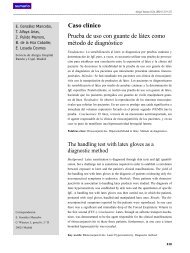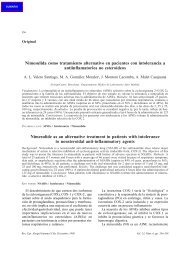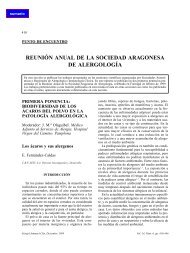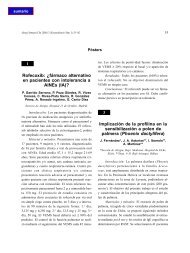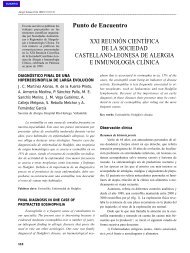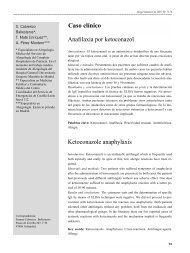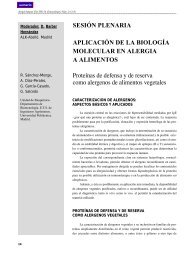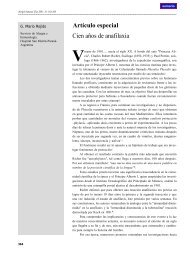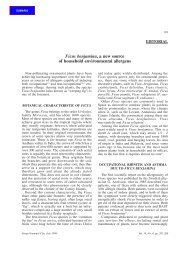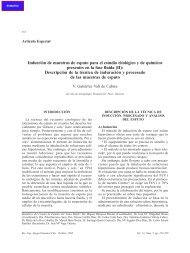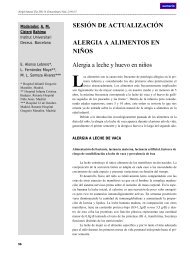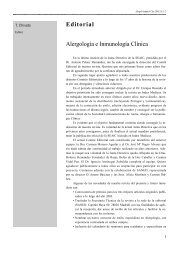Antihistamines: a review
Antihistamines: a review
Antihistamines: a review
You also want an ePaper? Increase the reach of your titles
YUMPU automatically turns print PDFs into web optimized ePapers that Google loves.
302 I. J‡uregui Presa Volume 14<br />
Cetirizine 13,14 reduces the attraction of inflammatory<br />
cells to the inflammatory focus after antigen<br />
challenge and inhibits the expression of the intercellular<br />
adhesion molecule 1 (ICAM-1) on the surface<br />
of epithelial cells. It also might be able to block the<br />
antigen-induced production of leukotrienes (LTC 4) 15 .<br />
Loratadine and its metabolite decarboethoxyloratadine<br />
inhibit the release of tryptase and amacroglobulin<br />
16 , of interleukins (IL) 6 and 8 17 and<br />
of leukotrienes and prostaglandin D2 (PGD2) 18 , and<br />
also the expression of ICAM-1 and of HLA-II<br />
antigens on the surface of epithelial cells 19 .<br />
Terfenadine inhibits the inflammatory cellular<br />
infiltrate and the eosinophil activation products in<br />
nasal lavage fluid and also the expression of surface<br />
ICAM-1 20 . It may also inhibit the release of leukotrienes<br />
from basophils and eosinophils and of<br />
histamine from basophils, as well as inhibiting skin<br />
reactivity to the platelet activation factor (PAF) 15 .<br />
Topical azelastine, which was initially studied as<br />
a "dual action" antihistamine with a clinical profile<br />
similar to that of ketotifen or oxatomide 2 , also seems<br />
to inhibit the eosinophyllic infiltrate and the expression<br />
of surface ICAM-1 in nasal epithelial cells 21 .<br />
Ebastine might have an antagonist action on the<br />
IgE-induced release of PGD2 and LTC 4/D 4 22 .<br />
A recent study in a rat model ascribes to mizolastine<br />
an antiinflammatory effect on the skin<br />
reaction induced by arachidonic acid 23 .<br />
Finally, fexofenadine inhibits the spontaneous<br />
release of IL-6 in fibroblast cultures 24 and the<br />
eosinophil-induced release of IL-8 and GM-CSF,<br />
as well as the expression of surface ICAM-1 in<br />
cultures of nasal epithelial cells.<br />
These antiinflammatory effects of antihistamines<br />
are not considered to be linked to H 1 receptor blockage.<br />
As they have mostly been demonstrated in<br />
vitro and with experimental concentrations of the<br />
drugs that are much higher than those achieved in<br />
vivo with the usual pharmacological dosages, their<br />
relative importance within the overall spectrum of<br />
the clinical efficacy of these drugs is still unknown 15 .<br />
PHARMACOKINETICS AND<br />
PHARMACODYNAMICS<br />
Almost all the H1 receptor antagonists have<br />
adequate oral absorption and can achieve maximal<br />
plasma concentrations within the 24 hours follo-<br />
Cl<br />
HN<br />
N<br />
HISTAMINA<br />
HISTAMINE<br />
CH 2 CH 2 NH 2<br />
CHLORPHENYRAMINE<br />
CLORFENIRAMINA<br />
N<br />
PRIMERA FIRST-GENERATION GENERACIîN DE ANTAGONISTAS H1 RECEPTOR ANTAGONISTS<br />
DE RECEPTORES H1<br />
Cl<br />
CH CH 2 CH 2<br />
CH O CH 2<br />
CH 2<br />
DIPHENHYDRAMINE<br />
DIFENHIDRAMINA<br />
Fig. 1a. Primary structure of histamine and of various H1<br />
antihistamines.<br />
wing administration. Most of the second-generation<br />
antihistamines, with the exception of acrivastine,<br />
cetirizine, levocabastine, fexofenadine and<br />
perhaps some other active metabolites experience<br />
hepatic first-pass metabolism, so that the plasma<br />
concentrations of the parent drugs are usually<br />
indetectable a few hours after administration 26 .<br />
Nevertheless, the effects of the antihistamines, as<br />
documented in studies of inhibition of histamineinduced<br />
skin reactions, persist over a time that is<br />
variable for each compound (Table II). This might<br />
be due to a greater tissue concentration, or to active<br />
metabolites maintaining the effect 27 .<br />
Because all the H1 receptor antagonists inhibit<br />
the skin reactions induced by histamine, this test<br />
has become a standardised biologic test for the<br />
action of antihistamines 15 . However, as several<br />
authors have pointed out 28 , there is not always a<br />
N<br />
OH N N CH2CH2 O CH2CH2 O<br />
H<br />
N<br />
CH 3<br />
CH 3<br />
CH 3<br />
CH 3<br />
HIDROXICINA<br />
HYDROXYZINE




